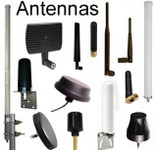Antennas, Antenna Cables, Wireless Products: Technical Articles
Massive MIMO: Game-Changer Cornerstone of 5G Networks
Table of Contents
Massive MIMO
Massive MIMO uses a very high number of antennas at a base station to dramatically enhance the quality of signal and ramp up the quality of data connections. The key benefit of Massive MIMO is that it has bigger and better capabilities.
Wide-reaching antenna systems use a type of wireless communication technology called Massive MIMO. This is largely prominent in 5G networks, which is the fifth generation of wireless cellular networks providing quicker speeds and more dependable services. So, what is Massive MIMO and how is it utilized to boost signal strength, and significantly improve network capacity?

Massive MIMO: Defined
Massive MIMO stands for Massive Multiple Input Multiple Output, and as insinuated by the name, it uses a very high number of antennas at a base station to dramatically enhance the quality of signal and ramp up the quality of data connections. The key benefit of Massive MIMO is that it has bigger and better capabilities, and it can hone in on the energy of the transmitted signal towards certain recipients via advanced beamforming.
This has clearly impacted the evolution of antenna design in 5G networks, and has surpassed all conventional systems. In this article, we’ll delve more into the ways that Massive MIMO has reshaped antenna design, as well as touching upon some highly recommended products from the Data Alliance collection. Whether you’re looking for 5GHz antennas or a high-quality antenna cable, you can explore our detailed, troubleshooting guides and find everything you need via our full suite of products on our website.
Improved End-User Experience: Massive MIMO
Due to recent technological improvements, Massive MIMO has swiftly become the go-to option for wide reaching deployments in 5G mobile networks. Massive MIMO is able to facilitate the highest quality beamforming processes, and MIMO techniques. This not only enhances end-user experience, but also boosts the quality of wireless frequencies, coverage and capacity.
The Impact on Antenna Design
The evolution and design of cellular antennas and 5G antennas due to Massive MIMO is important to understand, so let’s break down some of the most significant impacts:
Advanced Beamforming Capabilities
Digital beamforming is a vital element of antenna design, as the signal needs to be precisely targeted towards specific users. Beamforming will be explained in more detail later in this article.
Heightened Antenna Density
Massive MIMO requires a higher number of antennas closely positioned together in a very small space at the base station. This means that antennas need to be designed to provide high quality performance whilst keeping physical constraints in mind.
Size and Integration
Innovative materials and fabrication techniques are being used to create more compact antenna elements, which still allow good radiation abilities. When it comes to design it’s important to miniaturize the antenna without compromising on performance.
Multi-Band Design
In order to support various frequency bands used in 5G networks, antennas need to be carefully designed to operate across multiple frequencies with good isolation between bands. Designing a multiband antenna usually involves using multiple smaller antennas, or narrowband components, all of which are active at a specific frequency. Using multiple resonant units, active parts, and carefully designed slots and etchings, the antenna can produce multi-band frequency capabilities. Here you will find some more prime examples of LTE antennas with multiband capabilities.
More About Beamforming
Beamwidth is the angular proportion of the surrounding area of an antenna where the signal is at its optimum level. This angle also tends to be where the antenna’s power radiates most.
Beamwidth is the angular size of the area around an antenna where signal reception is best. It's the angle at which the antenna's power radiates most. As transmission occurs, beamforming is the ability to direct radio power through the channel and towards a specific receiver. Beams that are formed continually adapt to the surroundings to provide high performance in both UL and DL.
What Is Gain?
Gain measures the ability of an antenna, and how much it can directly input power into radiation in a certain direction. The gain of an antenna is measured in decibels or dB, and indicates its efficiency when it comes to transforming inputted power into radio waves. The higher the gain and dBi, the more far-reaching and focused the signal is. On the other hand, it doesn’t necessarily mean that the antenna is increasing the existing signal power; it is creating a more efficient process when focusing the power.
Why Does Gain Matter With MIMO Antennas?
The gain of a MIMO antenna most certainly matters, and it’s vital to consider the coverage area in mind and signal strength when choosing an appropriate antenna. Let’s see why Gain matters in antennas:
Gain enhances coverage
A high gain antenna will have a more focused beam and a coverage area that is much smaller. However, a low gain antenna beam would be broader with a more expansive area of coverage.
Gain improves performance
The higher the gain, the better the performance of the MIMO system overall, as it provides a more focused and strengthened system. This also creates higher data rates and improved signal quality.
Gain affects alignment
Alignment is vital to consider, as high-gain antennas are much more sensitive. It’s important to ensure the signal is properly directed where it’s intended with precise alignment.
For a deeper insight on antenna gain, and how to ensure antennas are working in the most effective way possible, it may be useful to learn more about signal attenuation and Front to Back Ratio directional antennas via our informative blog.

Key Takeaways: Massive MIMO
It is evident that Massive MIMO technology is a cornerstone of 5G networks, and has enabled base stations to handle multiple data streams simultaneously. Massive MIMO is reshaping antenna design in numerous ways to significantly boost capacity and range. Antenna reshaping and evolution continues to improve alignment, performance and coverage. For more information regarding Massive MIMO and state of the art antennas, cables, adapters, boosters and more explore the wide range of products at Data Alliance today.
FAQs
What is Massive MIMO?
Massive MIMO (Massive Multiple Input Multiple Output) is a wireless technology that uses a very high number of antennas at a base station to significantly enhance signal quality, data rates, and overall network capacity—especially in 5G networks.
How does Massive MIMO improve 5G performance?
By combining advanced beamforming and multiple antenna elements, Massive MIMO boosts coverage, reduces interference, and enables higher data throughput, creating a faster and more reliable user experience in dense environments.
What role does beamforming play in Massive MIMO?
Beamforming in Massive MIMO precisely directs radio signals toward intended users, rather than broadcasting in all directions. This increases efficiency, improves signal strength, and dynamically adapts to changing environments.
Why are so many antennas needed in Massive MIMO?
A high density of antennas allows base stations to transmit multiple data streams simultaneously to many users. This design dramatically increases network capacity and supports the heavy demand of 5G traffic.
How does antenna design change for Massive MIMO systems?
Massive MIMO antennas must balance compact size with performance, support multi-band frequencies, and use innovative materials to fit many elements into small spaces—all while maintaining strong radiation and coverage.
What is antenna gain, and why does it matter in MIMO systems?
Antenna gain measures how efficiently input power is focused into radio waves in a specific direction. Higher gain provides stronger, more focused signals but requires precise alignment, while lower gain offers broader coverage.
How does antenna gain impact performance in Massive MIMO?
Higher gain improves signal quality, coverage precision, and data rates, while lower gain provides wider coverage areas. The choice depends on the intended application and environment of the MIMO deployment.
Why is Massive MIMO considered a cornerstone of 5G networks?
Massive MIMO enables base stations to handle multiple data streams simultaneously, expanding coverage, improving alignment, and increasing network efficiency. It is one of the key technologies making 5G faster and more reliable.







